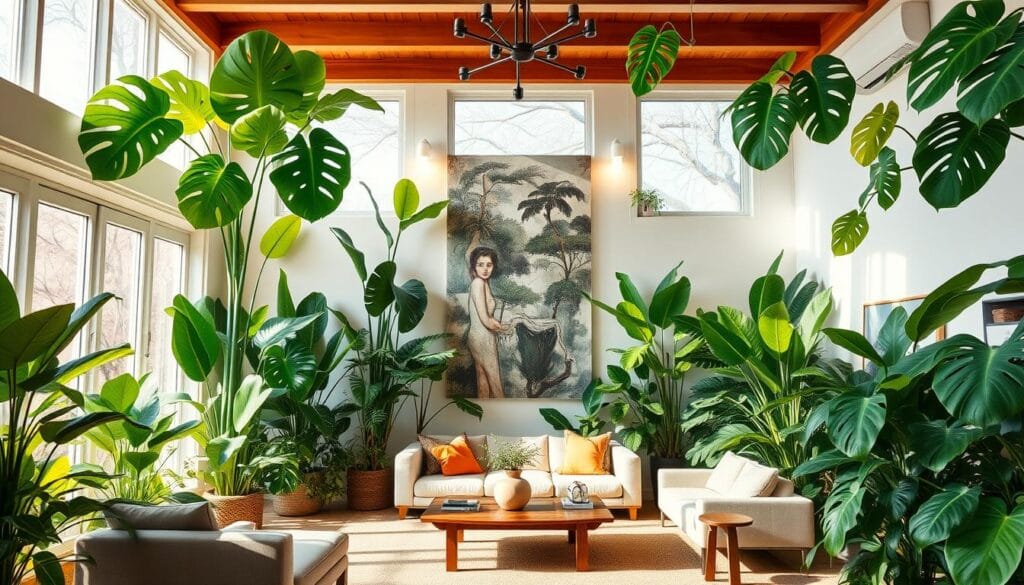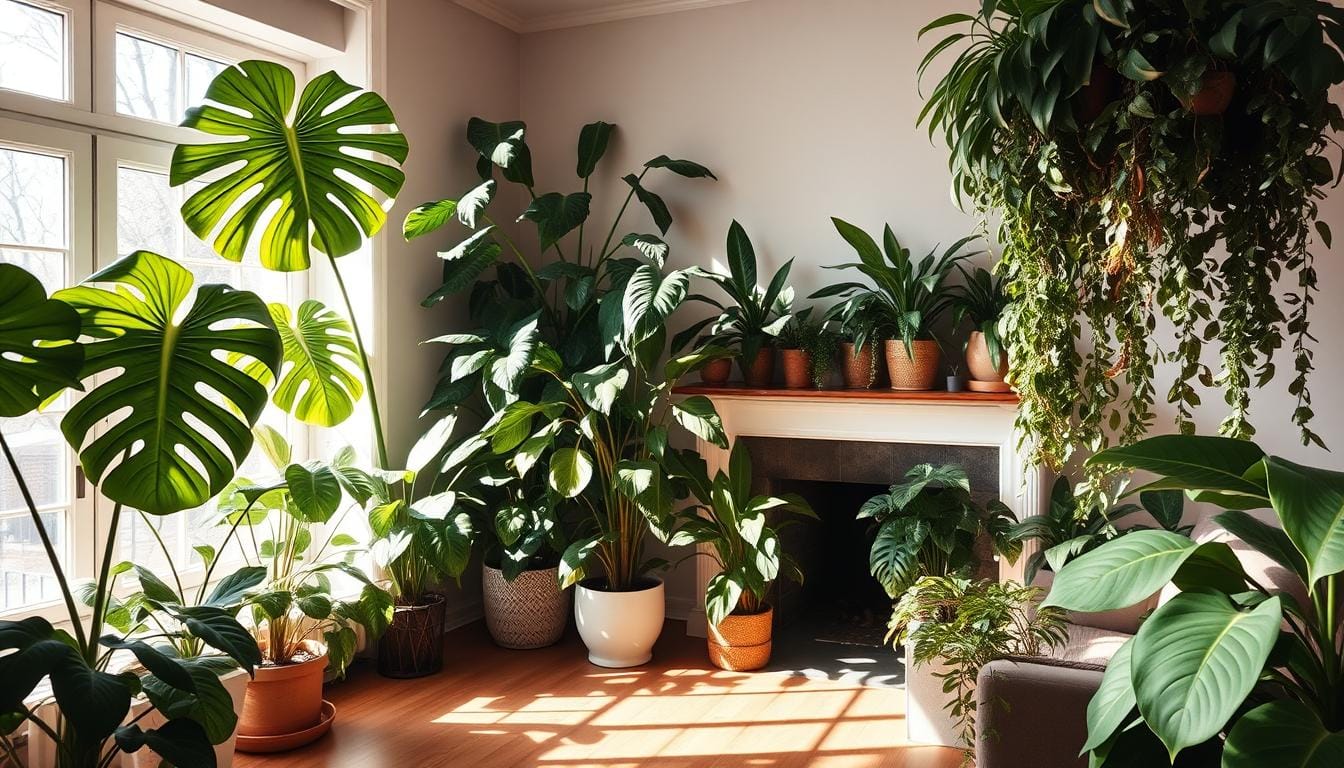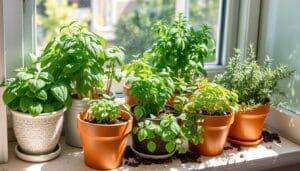Table of Contents
Big house plants can totally change your home’s look. They add color, structure, and a cozy feel. Plants like the Monstera and Ficus trees make a big impact right away. They’re great for decorating and as gifts for new homes.
Plants like the Burgundy Rubber Plant, Bird of Paradise, and Madagascar Dragon Tree can make any room feel fancy. They can make a living room, entryway, or office look amazing. By placing these plants well, you can make a beautiful centerpiece that draws the eye and lifts the mood.

Key Takeaways
- Large indoor plants have the power to transform any space, instantly elevating the style and ambiance.
- Mature, lush plants like Monstera, Ficus, and Bird of Paradise act as living works of art, bringing color, structure, and coziness to a room.
- Oversized houseplants offer immediate impact, eliminating the wait for growth, making them perfect for home decor and housewarming gifts.
- Strategically placing these towering plants can create stunning focal points that captivate and inspire.
- Proper care for big house plants is essential, including attention to light, watering, humidity, and maintenance.
Understanding the Impact of Large Indoor Plants
Towering potted plants and giant houseplants can change any room. They bring grandeur and a big visual impact. This is more than what smaller plants can offer.
Benefits of Large Plants vs Small Plants
Big indoor plants have strong roots, making them tough and adaptable. They clean the air and make spaces feel natural. They also make us feel connected to nature, boosting our mood and productivity.
How Big Plants Transform Interior Spaces
Giant houseplants can split a room into different areas. They also catch the eye, adding elegance. Placed right, they can hide ugly spots, brighten colors, and make rooms feel bigger and welcoming.
The Psychology of Living with Large Plants
Big plants have a big effect on our minds. Studies show people like being near them, feeling safe and calm. This connection to nature can lower stress and increase focus, making big plants great for homes and offices.
“Large plants create a strong and powerful ambience in home and office spaces, enhancing the overall impact and scale of a room.”
Popular Big House Plants for Your Home
Make your home spaces grand with massive indoor greenery and jumbo houseplants. These big plants add drama and life to any room. They range from lush tropical plants to unique shapes, changing your home’s look.
- Bird of Paradise (Strelitzia nicolai): This plant grows up to 30 feet tall. Its orange and blue flowers make a bold statement.
- Kentia Palm (Howea forsteriana): Its feathery fronds and tall shape bring tropical elegance to your space.
- Janet Craig (Dracaena fragrans): This plant’s long, sword-shaped leaves do well in low light. It’s perfect for dark corners.
- Areca Palm (Dypsis lutescens): Known as the “Bamboo Palm,” it has delicate leaves. Its growth habit adds a natural feel to any room.
- Rubber Plant (Ficus elastica): Its glossy leaves and strong growth make it a stylish choice for adding drama.
These are just a few of the big house plants that can change your home. Let massive indoor greenery and jumbo houseplants turn your home into a peaceful, natural oasis.

“Bringing the outdoors in with large, lush plants is one of the best ways to create a calming, biophilic atmosphere in your home.”
Creating Stunning Focal Points with Towering Plants
Bring the outdoors into your home with colossal houseplants. These large plants can turn any room into a peaceful oasis. By choosing the right spot, design, and light, you can make your home look amazing.
Strategic Placement Tips
Place tall, mature plants in corners or behind couches. Use them as living art to fill empty walls. Group smaller plants together for a bigger effect, or surround seating with greenery for a cozy feel.
Design Principles for Large Plants
Think about design when adding big plants to your space. Match the plant’s size with the room’s furniture and walls. Pick plants that fit your room’s style and colors. Mix different plant sizes and textures to add depth and interest.
Light Considerations for Statement Plants
Lighting is key for your plants’ health. Put sun-loving plants like Bird of Paradise and Monstera deliciosa near windows. For darker spots, choose plants like Kentia Palm or Philodendron Florida that do well in shade.

Best Locations for Massive Indoor Greenery
Adding enormous houseplants and big indoor trees to your home can make it look amazing. These plants can brighten up any room, from living rooms to bathrooms. They add beauty and make your home feel more welcoming.
Living rooms are perfect for tall, eye-catching plants. Try using Ficus trees, Monstera deliciosa, and rubber plants in big pots. They make your living space feel more luxurious. For entryways, dark plants like Melany or Abidjan rubber trees catch the eye.
Large plants near desks can help you work better. Studies show they improve focus, air quality, and happiness at work.
Use tall, narrow pots to fill dark corners with plants. Ficus, Monstera, and Snake Plants work well here.
Bathrooms are great for plants that love humidity. The steam from showers is perfect for plants like Lady Palm and Trichilia Emetica.
| Plant | Price | Best Location |
|---|---|---|
| Euphorbia Ammak | $261 | Living Room, Entryway |
| Cyathea cooperi (Australian Tree Fern) | $69 | Bathroom, Shaded Corner |
| Ficus Elastica (Rubber Plant) | $50 | Workspace, Living Room |
| Rhapis Excelsa (Lady Palm) | $38 | Bathroom, Entryway |
| Trichilia Emetica (Natal Mahogany) | $88 | Bathroom, Shaded Corner |
| Monstera Deliciosa | $56 | Living Room, Workspace |
| Pachira aquatica (Money Tree) | $34 | Entryway, Workspace |
Placing big plants in smart spots can change your home. It boosts productivity and makes your home feel lush and inviting.

Essential Care Guide for Giant Houseplant Varieties
Caring for large indoor plants needs a special approach. This ensures they grow well and look great. Whether you’ve just got a giant houseplant or want to keep your big houseplant varieties healthy, knowing their needs is key.
Watering Requirements
How often to water large indoor plants depends on the type. Generally, water when the top two inches of soil feel dry. Use a potting mix that drains well and containers with holes to avoid waterlogged soil. For example, snake plants (Sansevieria trifasciata) need watering only once or twice a week. On the other hand, dumb canes (Dieffenbachia) like their soil moist but not soggy.
Light and Temperature Needs
Most big indoor plants do well in bright, indirect light. Some, like peace lilies (Spathyphillum), can handle medium light. Make sure your plants get the right amount of sunlight to keep their leaves green. Also, keep them in a temperature range of 65-85°F to help them grow.
Maintenance and Pruning
Regular care is vital for your plants to stay healthy. Fertilize them monthly with a houseplant fertilizer to give them nutrients. Prune them as needed to keep their shape and size right. Also, clean their leaves often to remove dust, which can block photosynthesis.
By knowing how to care for large indoor plants and big houseplant maintenance, you can make your space beautiful. Your indoor oasis will be filled with greenery that brings nature and calmness inside.
“Caring for large indoor plants is a labor of love, but the rewards of having a lush, verdant space are well worth the effort.”
| Plant Species | Watering Needs | Light Requirements | Fertilizer Recommendations |
|---|---|---|---|
| Snake Plant (Sansevieria trifasciata) | Water once or twice a week | Tolerates fluorescent light, prefers more direct light | 20-20-20 fertilizer once in the spring |
| Dumb Cane (Dieffenbachia) | Water once or twice a week, keep soil moist but not wet | Prefers filtered light to protect large leaves | Water-soluble fertilizer twice a month |
| Peace Lily (Spathyphillum) | Water when soil is dry to the touch | Tolerates low light, performs best in medium light | Granule fertilizer twice a year |
Decorating Different Rooms with Oversized Plants
Make your home stand out with large, eye-catching plants. They can change your living room, entryway, or workspace into something special. These plants add natural beauty and elegance to any space.
In the living room, add plants like the Ginny Mini Monstera or Ficus umbellata. They help you relax and make the room feel luxurious and cozy. Decorating with large plants can really improve a room’s style and feel.
Use tall plants in your entryway to impress visitors. Indoor plant styling with these plants can turn a plain area into a lively spot.
Large plants in your home office or study can help you work better. They improve air quality and make you feel better, making them great for any decorating with large plants workspace.
Bedrooms are perfect for big, calming plants. Try a tropical philodendron or other big-leaved plants. They bring peace and elegance to your bedroom.
In the dining room, tall plants can make the space special. These indoor plant styling elements can make your dining area more inviting and interesting.
| Room | Ideal Large Plant Varieties | Benefits |
|---|---|---|
| Living Room | Ginny Mini Monstera, Ficus umbellata | Encourages relaxation, creates a cozy, luxurious atmosphere |
| Entryway | Towering, eye-catching plants | Transforms a dull space, makes a lasting impression on guests |
| Home Office | Large, beautiful plants | Increases productivity, concentration, and air quality |
| Bedroom | Tropical philodendron, large-leaved varieties | Creates a serene, spa-like ambiance |
| Dining Room | Tall, statement plants | Defines the space, adds a touch of nature |
Decorating with big plants is a lasting trend. Adding these plants to your home can make any space feel lush and welcoming. They promote relaxation, productivity, and a closer connection to nature.

Common Challenges with Large Indoor Plants
Keeping big plants healthy in your home is rewarding but comes with challenges. Space issues and pests are common problems. Knowing these issues helps you care for your plants better.
Space Management Solutions
Big plants can take over a room. Use tall, narrow pots to save space. Place plants in corners or against walls to use space wisely.
Dealing with Growth and Pruning
As plants grow, they need regular pruning. Cut only what’s needed to keep them looking good. Know how your plant grows and prune carefully.
Pest Prevention for Large Plants
Big plants are more likely to get pests. Check your plants often for signs of pests. Use neem oil or insecticidal soap to prevent pests like spider mites and aphids.
Understanding and tackling big plant problems and large houseplant issues ensures your plants thrive. They will make your home beautiful for years.

Selecting the Right Containers for Colossal Plants
Choosing the right container is key for large indoor plants. Large plant pots and big indoor planters are essential. They not only display your plants but also keep them healthy and stable.
Material matters a lot. Ceramic, terracotta, and plastic pots each have benefits. Ceramic adds elegance, terracotta helps roots breathe, and plastic is light with self-watering options.
Pot size is also crucial. The container must fit your plant’s mature size. This allows for root growth and healthy development. Tall, sturdy pots are needed for tall plants to prevent them from falling over.
Drainage is vital in big indoor planters. Look for pots with lots of drainage holes. This prevents waterlogging and keeps soil moisture right.
Think about how the pot looks too. Pick one that matches your home’s style. This way, you’ll have a beautiful piece that shows off your love for big, green plants.
Seasonal Care Tips for Mammoth Indoor Plants
As the seasons change, it’s key to adjust your care for mammoth indoor plants like the Portulacaria afra ‘Mammoth’. In spring and summer, when they grow fast, water and fertilize more often. Also, add humidity by misting or using a pebble tray, especially in dry winter months.
In autumn and winter, water less and don’t fertilize. These big plants slow down and need less water and food. Rotate them for even light and clean leaves often to keep them looking good. Watch for pests all year, but more during temperature changes.
By changing your seasonal plant care and indoor tree care, you can make these mammoth plants flourish. They’ll help create a beautiful, green indoor space all year.
FAQ
What are the benefits of large indoor plants compared to smaller plants?
Large indoor plants have many advantages over smaller ones. They make great focal points and divide rooms naturally. They also fill big spaces well.
Big plants have strong roots, making them more stress-resistant. They improve air quality, reduce stress, and add luxury to a room.
What are some popular large house plant varieties?
Some popular large house plants are the Bird of Paradise and the Kentia Palm. The Janet Craig and Areca Palm are also favorites. The Rubber Plant and Dragon Tree are known for their size.
The Fiddle Leaf Fig and Weeping Fig are popular for their looks. The Money Tree and African Fig Tree are also well-liked. Yucca and Banyan Fig plants are known for their size and beauty. The Swiss Cheese Plant and Umbrella Plant are also popular choices.
How should I strategically place large indoor plants in my home?
Place tall plants in corners and behind couches for a stunning look. Use them as art to fill empty walls. Group smaller plants together for a bigger impact.
Surround seating areas with plants for a cozy feel. Remember to consider the light needs of your plants. Place high-light plants near windows and low-light plants in darker spots.
What are the best locations for large indoor plants in a home?
Large indoor plants are great in living rooms, entryways, and workspaces. They can make empty corners look better. Bathrooms are also good places for them, especially for plants that like humidity.
In living rooms, tall plants can make the area feel luxurious. Entryways can be welcoming with striking plants. Workspaces can be more productive with plants around. Use plants to make dull corners look lush. Bathrooms benefit from plants that like humidity.
How do I care for large indoor plants?
Caring for large indoor plants depends on the type. Generally, water when the top two inches of soil are dry. Use soil that drains well and containers with holes.
Provide bright, indirect light and keep humidity right. Fertilize monthly and clean leaves to remove dust. Prune plants to keep them the right size and shape.
What are some common challenges with large indoor plants?
Common issues with large indoor plants include managing space and controlling growth. Use narrow containers for tight spaces. Prune regularly to keep plants the right size.
To prevent pests, check plants often, keep watering and humidity right, and treat with neem oil or insecticidal soap if needed.
What types of containers should I use for large indoor plants?
Choose containers that match your decor and support your plants. Make sure pots have holes for drainage. For tall plants, use sturdy containers to avoid tipping.
Consider the plant’s mature size when picking a pot. Use ceramic, terracotta, or plastic pots based on your plant’s needs and your style.
How do I adjust care routines for large indoor plants throughout the seasons?
Adjust care for large indoor plants with the seasons. In spring and summer, water and fertilize more as plants grow. Keep humidity up in dry winter months.
In fall and winter, water and fertilize less as growth slows. Rotate plants for even light and clean leaves more in dusty seasons. Watch for pests all year, but be extra careful during temperature changes.





